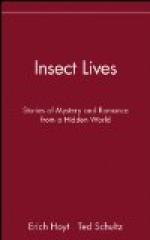[Illustration: Fig. 8 a, b. Dragon-fly (Aeschna cyanea). Two stages in emergence of fly from nymph-cuticle. From Latter’s Natural History.]
[Illustration: Fig. 8 c. Dragon-fly emerged, wings expanding. From Latter’s Natural History.]
[Illustration: Fig. 8 d. Dragon-fly (Aeschna cyanea) with expanded wings.]
The life-story of a may-fly follows the same general course as that just described for the dragon-flies, but there are some suggestive differences. In the first place, we notice a wider divergence between the imago and the larva. An adult may-fly is one of the most delicate of insects; the head has elaborate compound eyes, but the feelers are very short, and the jaws are reduced to such tiny vestiges that the insect is unable to feed. Its aquatic larva is fairly robust, with a large head which is provided with well-developed jaws, as the larval and nymphal stages extend over one or two years, and the insects browse on water-weeds or devour creatures smaller and weaker than themselves. They breathe dissolved air by means of thread-like or plate-like gills traversed by branching air-tubes, somewhat resembling those of the demoiselle dragon-fly larva. But in the may-fly larva, there is a series of these gills (fig. 9_b_) arranged laterally in pairs on the abdominal segments, and C. Boerner (1909) has recently given reasons, from the position and muscular attachments of these organs, for believing that they show a true correspondence to (in technical phraseology are homologous with) the thoracic legs. One feature in which the larva often agrees with the imago is the possession on the terminal abdominal segment of a pair of long jointed cerci, and in many genera a median jointed tail-process (see fig. 9) is also present, in some cases both in the larva and the imago, in others in the larva during its later stages only. The prolonged larval life in may-flies often involves a large series of moults; Lubbock (1863) has enumerated twenty-one in the life-history of Chloeon. In the second year of aquatic life wing-rudiments (fig. 9 a) are visible, and the larva becomes a nymph. When the time for the winged condition approaches the nymphs leave the water in large swarms. The vivid accounts of these swarms given by Swammerdam (1675), de Reaumur (1742) and other old-time observers are available in summarised form for English readers in Miall’s admirable book (1895). May-flies are eagerly sought as food by trout, and the rise of the fly on many lakes ushers in a welcome season to the angler.
The nymph-cuticle opens and the winged insect emerges. But this is not the final instar; may-flies are exceptional among insects in undergoing yet another moult after they have acquired wings which they can use for flight. The instar that emerges from the nymph-cuticle is a sub-imago, dull in hue, with a curious immature aspect about it. A few hours later the final moult takes place, a very delicate cuticle being shed and revealing the true imago. Then follow the dancing flight over the calm waters, the mating and egg-laying, the rapid death. The whole winged existence prepared for by the long aquatic life may be over in a single evening; at most it lasts but for a few days.




